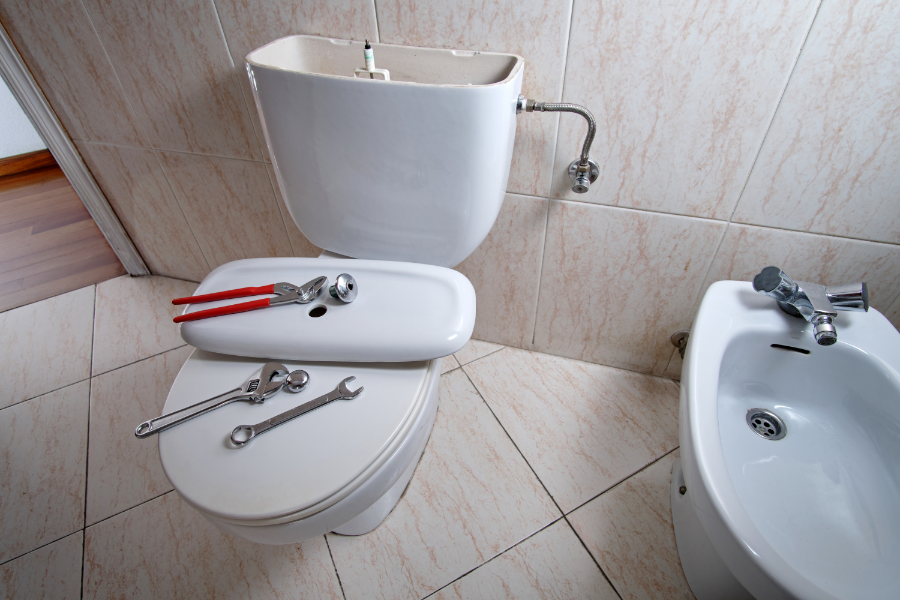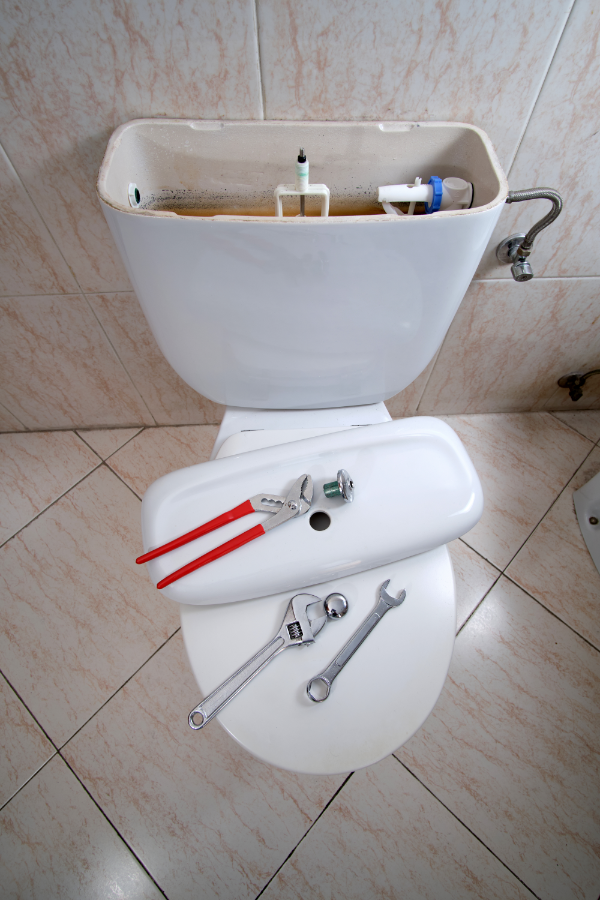Toilet troubles can be a real headache, especially when you have a broken toilet handle that gives up on you. But don’t worry, we’ve got you covered. Let’s dive into the world of toilet mechanics and learn how to flush a toilet with a broken handle.
Table of Contents
The Inner Workings of Your Toilet
Before we get our hands dirty, it’s crucial to understand the mechanism behind the humble toilet. The toilet system is more than just a handle and a bowl. It’s a complex assembly of parts working in harmony to ensure a smooth flush.
The handle is connected to a lift arm inside the tank, which is attached to a flapper. When you press the handle, the lift arm raises the flapper, allowing water to rush from the tank into the bowl, causing the flush. Once the tank is empty, the flapper seals the tank, and it begins to refill for the next use.
Understanding this mechanism is the first step. It helps you identify the problem and apply the correct solution.
“Toilet Troubles? No Sweat!”
Understanding the inner workings of your toilet can empower you to tackle common issues.. It’s not rocket science, just a simple mechanism of levers and valves.
Spotting the Culprit: Is It Really the Handle?
Now that we know how a toilet works, let’s figure out if the handle is indeed the problem. Sometimes, the issue might lie elsewhere in the system.
Start by removing the tank lid. Check if the handle is loose or if it’s not connected to the lift arm. If the handle is loose, the problem might be a simple fix. If it’s broken or disconnected, you’ll need to replace it or reattach it.
But wait! Before jumping to conclusions, make sure the handle is the real culprit. Sometimes, the problem lies elsewhere in the flush system.
Remember, safety first! Always ensure your hands are dry when handling the toilet’s internal parts to avoid any accidents.

In the Meantime: Manual Flushing 101
While you’re figuring out the handle situation, you might need to manually flush your toilet. It’s a straightforward process. All you need is a bucket of water.
Fill a bucket with about a gallon of water.
Pour the water into the toilet bowl in one swift motion. The force of the water should mimic the action of a regular flush.
Repeat if necessary.
This method is a temporary fix and can be handy in emergencies. However, it’s not a long-term solution. Let’s move on to fixing that handle.
“Bucket to the Rescue”
A bucket of water can be your best friend when the handle breaks. A swift pour into the bowl can mimic a regular flush.
Loose Handle? No Problem
A loose handle is a common issue and often the easiest to fix. Over time, the nut inside the tank that holds the handle in place can loosen due to repeated use.
To tighten a loose handle:
Remove the toilet tank lid.
Locate the nut attached to the handle. It’s usually reverse-threaded, which means you’ll need to turn it clockwise to tighten it.
Use your hand or a wrench to gently tighten the nut. Be careful not to over-tighten as it could crack the toilet tank.
And voila! Your handle should now be firm and functional. If the handle is still not working, it might be time to replace it.
“Loose Handle? Tighten Up!”
A loose handle is often just a case of a reverse-threaded nut needing a little tightening. A simple fix for a common issue.
Taking the Plunge: Replacing Your Broken Toilet Handle
If your handle is beyond repair, it’s time to replace it. Don’t worry, it’s not as daunting as it sounds. With a few tools and a bit of patience, you’ll have your toilet flushing smoothly in no time.
Out with the Old
Before you can install a new one, you need to remove the old handle. Here’s how:
Start by draining the toilet tank. You can do this by turning off the water supply and then flushing the toilet.
Once the tank is empty, locate the nut that holds the handle in place. It’s usually reverse-threaded, so you’ll need to turn it counterclockwise to loosen it.
After removing the nut, you can pull the handle out of the tank. Be sure to remove the chain attached to the flapper.
“Out with the Old”
Removing a broken handle is the first step towards a smooth flush. Remember to drain the tank and disconnect the chain before you start.
In With the New
Now that you’ve removed the old handle, it’s time to install the new one. Follow these steps:
Insert the new handle into the hole in the toilet tank.
Secure the handle by screwing on the nut. Remember, it’s likely reverse-threaded, so turn it clockwise to tighten.
Attach the chain to the handle. Make sure it has enough slack to seal the flapper but not so much that it gets caught under the flapper after a flush.
“In with the New”
Installing a new handle is easier than you think. Just insert, secure, and attach the chain. Voila, you’re back in business!
Prevention is Better than Cure
To avoid future handle issues, regular maintenance is key. Here are a few tips:
Avoid using excessive force when flushing. A gentle push is all it takes.
“Handle with Care”
Toilet handles aren’t meant for rough handling. A gentle push is all it takes to flush. Treat your handle with care to extend its life.
Check the handle and its components regularly for any signs of wear and tear.
“Keep an Eye Out”
Regular checks can help you spot signs of wear and tear early. Prevention is better than cure, after all.
Clean the handle and the surrounding area to prevent buildup of grime that could affect its functionality.
“Cleanliness is Next to Godliness”
A clean handle is a happy handle. Regular cleaning can prevent grime buildup that could affect functionality.
By following these tips, you can extend the life and ensure a smooth flush every time.
“You’ve Got This!”
Dealing with a broken handle might seem daunting, but with a little knowledge and the right tools, you can handle it. So roll up your sleeves and tackle the problem head-on.

Flush with Success: You’ve Got This!
Dealing with this and having a hard time when you need to flush might seem like a daunting task, but as you’ve seen, it’s something you can handle with a little knowledge and the right tools. So the next time your toilet handle gives you trouble, don’t panic. Roll up your sleeves and tackle the problem head-on. You’ve got this!
Frequently Asked Questions
What Causes a Toilet Handle to Break?
It can break due to wear and tear over time. Excessive force when flushing can also cause the handle to break or become loose.
Can I Flush My Toilet If the Handle is Broken?
Yes, you can manually flush your toilet by pouring a bucket of water directly into the toilet bowl. However, this is a temporary solution and the handle should be fixed or replaced for regular use.
How Do I Know If It Needs Replacing?
If it is loose, doesn’t spring back after flushing, or doesn’t flush the toilet at all, it might need replacing. Sometimes, tightening the nut can fix a loose handle, but if the handle is broken, it will need to be replaced.
Do I Need a Plumber to Replace It?
Not necessarily. Replacing a toilet handle is a relatively simple task that most people can do themselves with a few basic tools. However, if you’re not comfortable doing it yourself, it’s best to call a professional.
How Often Should I Check My Toilet for Maintenance?
It’s a good idea to check your toilet for maintenance issues every few months. Regular checks can help you spot signs of wear and tear early and prevent bigger problems down the line.
Can I Prevent it from Breaking?
While you can’t prevent issues, regular maintenance and gentle use can help extend the life of your toilet handle. Avoid using excessive force when flushing and clean the handle regularly to prevent grime buildup.
More Reading:
